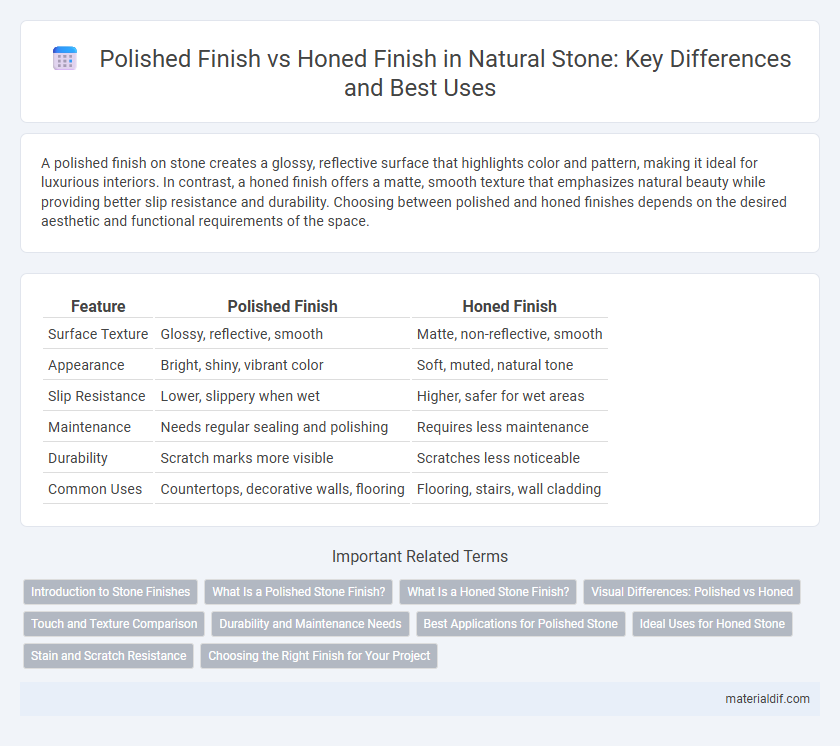A polished finish on stone creates a glossy, reflective surface that highlights color and pattern, making it ideal for luxurious interiors. In contrast, a honed finish offers a matte, smooth texture that emphasizes natural beauty while providing better slip resistance and durability. Choosing between polished and honed finishes depends on the desired aesthetic and functional requirements of the space.
Table of Comparison
| Feature | Polished Finish | Honed Finish |
|---|---|---|
| Surface Texture | Glossy, reflective, smooth | Matte, non-reflective, smooth |
| Appearance | Bright, shiny, vibrant color | Soft, muted, natural tone |
| Slip Resistance | Lower, slippery when wet | Higher, safer for wet areas |
| Maintenance | Needs regular sealing and polishing | Requires less maintenance |
| Durability | Scratch marks more visible | Scratches less noticeable |
| Common Uses | Countertops, decorative walls, flooring | Flooring, stairs, wall cladding |
Introduction to Stone Finishes
Stone finishes significantly impact both the aesthetic and functional qualities of natural stone surfaces. Polished finish enhances the stone's natural colors and patterns by creating a glossy, reflective surface ideal for marble and granite countertops. Honed finish offers a smooth, matte texture that reduces glare and provides a more subtle, contemporary look, commonly used in flooring and wall applications.
What Is a Polished Stone Finish?
A polished stone finish enhances the natural color and texture of the stone by creating a glossy, reflective surface through grinding and buffing with fine abrasives. This finish is commonly applied to marble, granite, and limestone, resulting in a smooth, mirror-like appearance that intensifies the stone's veining and patterns. Polished stone surfaces are highly resistant to stains and moisture but can be more prone to showing scratches compared to other finishes.
What Is a Honed Stone Finish?
A honed stone finish is a smooth, matte surface achieved by grinding the stone to remove its glossy top layer, resulting in a flat, non-reflective appearance. This finish highlights the natural texture and color variations of stones like marble, limestone, and travertine while offering enhanced slip resistance. Commonly used in flooring and wall applications, honed finishes provide a subtle, elegant look preferred in contemporary and rustic designs.
Visual Differences: Polished vs Honed
Polished stone finish exhibits a glossy, mirror-like surface that enhances color vibrancy and highlights natural patterns, making it ideal for decorative and high-impact areas. Honed finish features a smooth, matte appearance with a soft sheen, reducing glare and providing a more subdued, natural look suited for flooring and surfaces needing slip resistance. The choice between polished and honed finishes directly affects the stone's visual texture, depth, and overall aesthetic appeal in architectural and design applications.
Touch and Texture Comparison
A polished finish delivers a smooth, glossy surface that enhances the stone's natural color and veining, offering a sleek and reflective texture. A honed finish, by contrast, provides a matte, soft feel with a slightly abrasive texture that reduces glare and highlights the stone's natural character. The polished surface feels cool and firm under touch, while the honed finish offers a more tactile, muted sensation that is less slippery and better suited for high-traffic areas.
Durability and Maintenance Needs
Polished stone finishes offer a highly reflective surface that enhances durability by providing a protective layer against moisture and stains, making them easier to clean and maintain. Honed finishes, characterized by their matte appearance, are more prone to showing scratches and require regular sealing to preserve their resistance to wear and staining. Choosing between polished and honed stone surfaces depends on balancing the need for low maintenance with the desired aesthetic and wear resistance.
Best Applications for Polished Stone
Polished stone surfaces offer a high-gloss, reflective finish that enhances the natural color and veining of materials like granite, marble, and quartzite, making them ideal for luxurious countertops, accent walls, and flooring in residential and commercial spaces. This finish provides a durable, stain-resistant surface that is easy to clean, which is particularly beneficial in kitchens and bathrooms where hygiene and aesthetics are critical. Its smooth texture also aids in light reflection, brightening interiors and creating an elegant, sophisticated atmosphere.
Ideal Uses for Honed Stone
Honed stone is ideal for flooring and countertops in high-traffic areas due to its non-reflective, matte surface that minimizes glare and hides scratches effectively. Its smooth texture provides a comfortable and slip-resistant finish, making it perfect for residential bathrooms, kitchen islands, and commercial spaces where safety and durability are priorities. Honed finishes also work well for outdoor applications, blending naturally with the environment and resisting weathering better than polished stone.
Stain and Scratch Resistance
Polished finishes on stone surfaces offer superior stain resistance due to their non-porous, glossy layer that repels liquids and prevents deep absorption. Honed finishes, while less shiny, provide better scratch resistance because of their matte, textured surface that conceals minor abrasions more effectively. Choosing between polished and honed depends on prioritizing either high stain resistance or enhanced scratch concealment for stone maintenance.
Choosing the Right Finish for Your Project
Polished finishes enhance natural stone by creating a glossy, reflective surface that highlights color and veining, ideal for decorative applications like countertops and feature walls. Honed finishes provide a smooth, matte texture with reduced glare, offering a more subtle appearance suited for high-traffic areas and floors where slip resistance is important. Selecting the right finish depends on balancing aesthetic preference, durability needs, and maintenance requirements specific to the stone type and project environment.
Polished Finish vs Honed Finish Infographic

 materialdif.com
materialdif.com